Ironing board dimensions

An ironing board is an integral part of every home. It is necessary for a convenient and practical ironing of things. Modern manufacturers offer devices of various modifications for the choice of consumers. However, ironing boards differ not only in their functionality, but also in dimensional parameters. Today we will take a closer look at what types of ironing boards exist, and what dimensions they have.
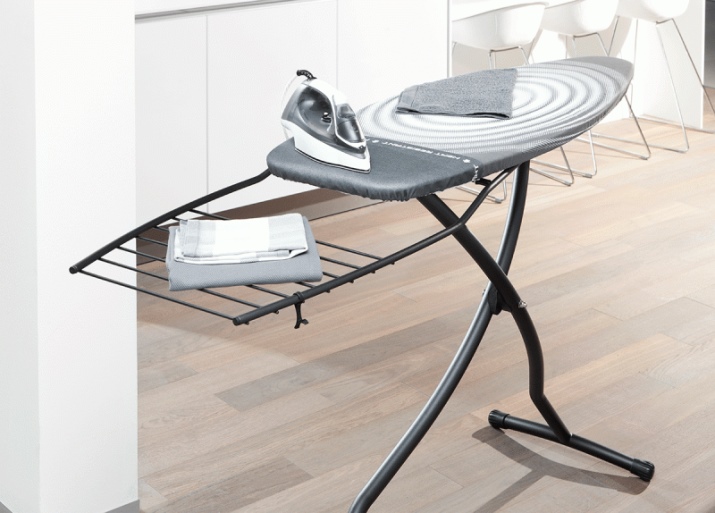
Varieties
There are several subtypes of ironing boards. Each of them has its own quality characteristics, structure and standard dimensional parameters. Let us examine in detail what types of these devices can be found in stores today.
Floor
Floor-standing ironing boards are more common than others. Their design unfolds until it takes the form of a comfortable table of sufficient height (there are models of different heights - from 40, 50 and 60 cm to the floor). Most of these models are very easy to assemble, as many housewives say. If you are used to ironing while standing, then a floor-standing structure will suit you best.
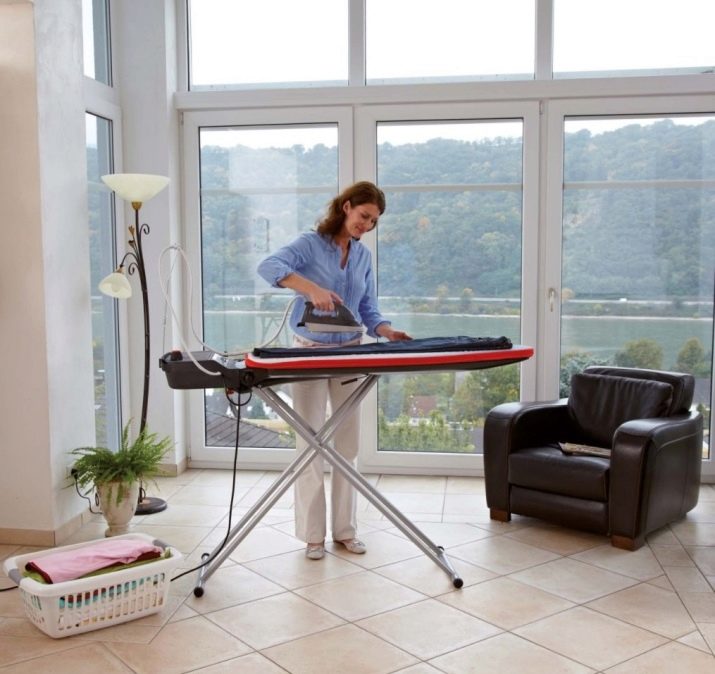
Initially, floor options were complemented by step adjustment systems. Of course, these examples can be found today, but, as a rule, in cheap and not too complicated products. In addition, relatively recently, multifunctional hybrid boards have appeared on the market, which can easily and quickly turn into convenient dryers. Some floor models can even transform into stepladders.
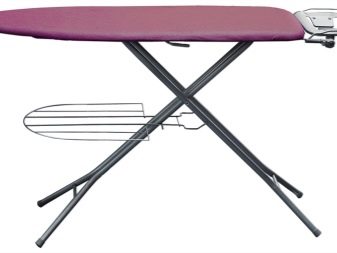
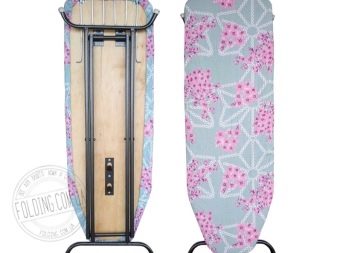
The main advantages of such products are:
- increased stability;
- characteristic dimensional parameters;
- rich sets with covers and other necessary additions;
- rubberized pads for the legs, thanks to which the structure does not harm the floor coverings;
- the presence of interesting and useful add-ons.
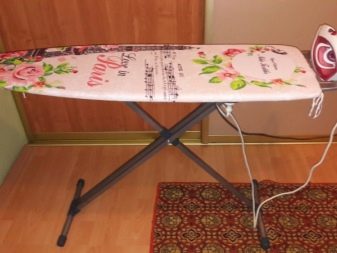

The disadvantages of floorboard models include the following parameters:
- in the unfolded state, such boards take up quite a lot of space, and usually they have an impressive weight, so it is not always possible to drag them from place to place or hang on hooks;
- It is undesirable to put these boards close to other furniture, otherwise such a "neighborhood" may interfere with the convenient and easy unfolding of the mechanism available in the product.
Tabletop
More compact and modest in all respects are modern ironing boards. In most cases, these models are equipped with very small legs. Table boards must be fixed on a table or other flat surface, and then used for their main purpose.
Tabletop models have small countertops that cannot be ironed on large items, such as bedding or large fluffy dresses. They are only suitable for working with shirts, T-shirts and other small items.
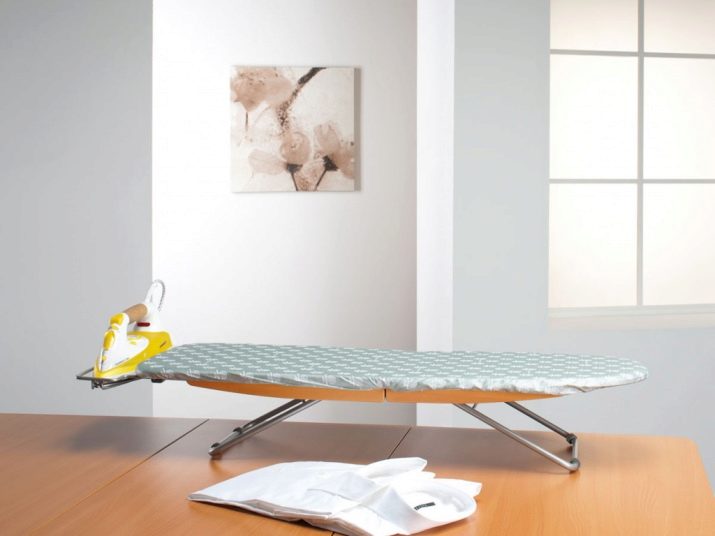
The main advantages of modern tabletop designs are:
- maximum stability - such a model will not fall to one side and will not fall during ironing;
- light weight and dimensions, especially relevant for small apartments;
- the arm sleeve included in the kit (its size is 50x9 cm);
- easy unfolding;
- compact dimensions (often such models are stored by hanging on hooks behind the door);
- mobility - such specimens can be easily transferred from one room to another.
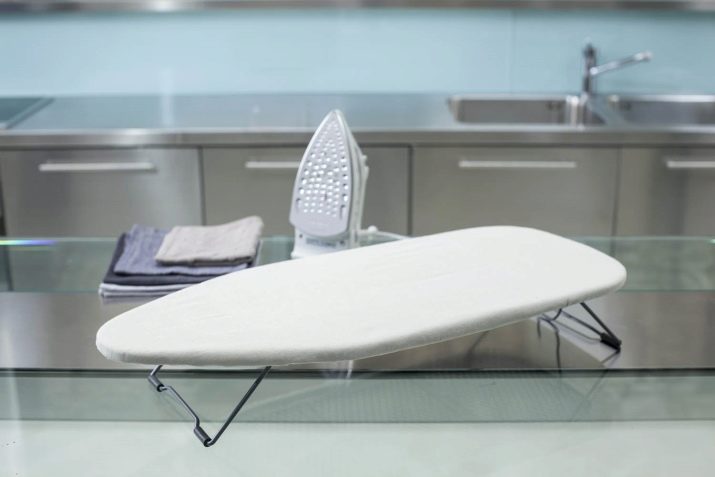
But such boards also have disadvantages:
- large things such as bed linen cannot be ironed on them;
- These structures cannot boast of high strength characteristics - it is quite possible to accidentally bend them during ironing.
Embedded
Built-in models of ironing boards are in great demand today. Every housewife dreams of such a convenient design. The popularity of such specimens is due to the fact that there is no need for them to search for a suitable place for a long time and scrupulously. In addition, household members do not have to drag heavy and bulky (wide and high) structures from one room to another.
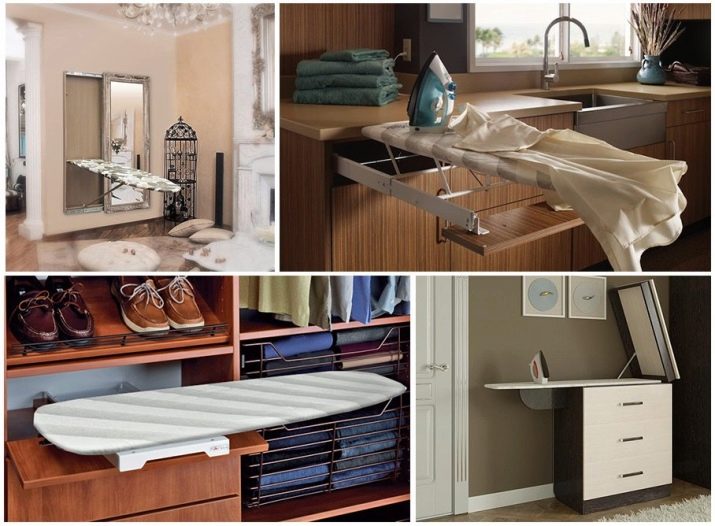
Experts recommend recessed boards for purchase also because they easily fit into a variety of interior compositions. These products do not spoil the atmosphere.
Let's consider the main advantages of these options:
- compact size;
- aesthetic appearance;
- easy-to-use mechanisms and systems for folding and unfolding the table top;
- the ability to hide the board behind a decorative disguise, for example, a mirror or panel;
- strong hold during ironing;
- the ability to withstand heavy loads;
- the presence of a built-in socket complete with many models.
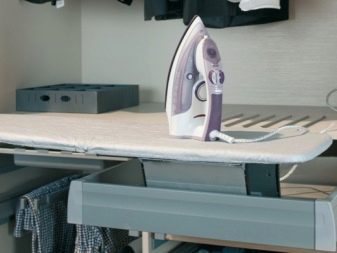
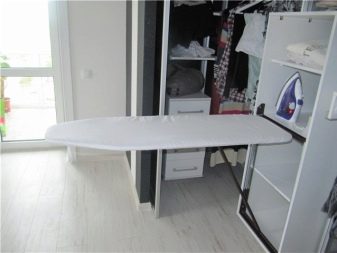
The only drawback is that the board cannot be moved after installation.
Transformable
Ironing "transformers" are no less popular today. These models are made in the form of bedside tables or dressers. At first glance, they can be easily confused with simple stationary furniture. By placing such a product in the room, it will be possible to significantly save free space. For a small apartment, such a board is a great option.
Despite the fact that these types of ironing boards are compact and easily fit into many interiors, they remain practical and functional. Often, housewives store many different things in them. It can be clothes or various accessories for ironing.
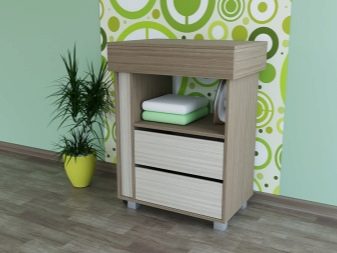
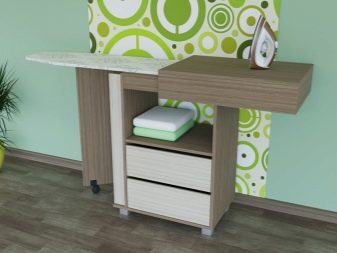
The main advantages of "transformers" are:
- high functionality;
- incomparable stability;
- aesthetic design that easily fits into many environments;
- availability of storage systems.
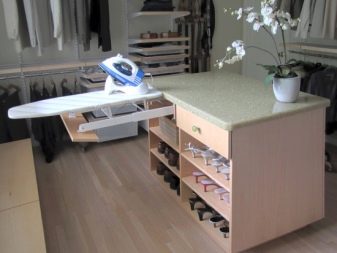

As for the disadvantages of transformable structures, these include:
- low mobility;
- impossibility of installation next to other furniture.
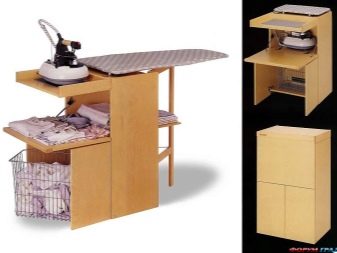
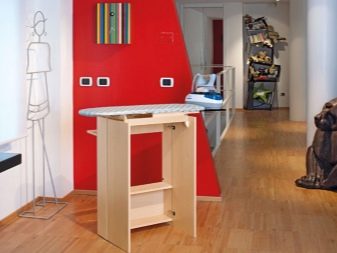
Materials (edit)
Ironing boards are both expensive and quite cheap. The price of such products is influenced not only by their functionality, but also by the material from which they are made. Let's take a closer look at what options are offered by modern manufacturers.
Pressed plates
Despite the seemingly simple and understandable name, such options are far from being made from ordinary boards. Similar specimens were made earlier, but today they have been replaced by more thought-out designs from woodworking waste. Such raw materials include MDF, chipboard or plywood sheets. They are inexpensive and very common. You won't have to look for such an option for a long time.
Pressed board countertops are made denser and stronger so that they can withstand the corresponding loads. However, it must be borne in mind that over time, structures made from such raw materials will inevitably absorb moisture into their structure, which will then lead to their stratification or swelling.

Thermoplastic
Plastic ironing boards are considered very light. Such specimens, despite their low weight, are quite strong and durable. They do not accumulate dampness or moisture, which has a positive effect on their service life. The main requirement that such a design must meet is the use of heat-resistant raw materials in production. Otherwise, it will simply begin to melt under the influence of the iron, which will very soon disable it.
Experts recommend giving preference not only to heat-resistant ones, but also to those options that have thermo-reflective properties. With these characteristics, the laundry will be ironed much easier. But buyers need to keep in mind that the last listed options will cost much more than the usual ones. However, heat-reflecting options are more effective, and they are chosen by many housewives. According to consumers, these models are well worth the money.
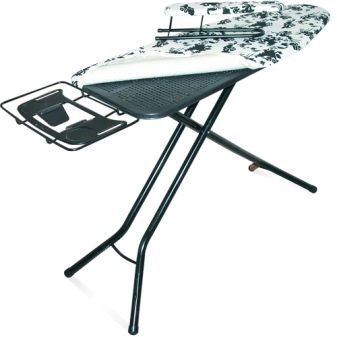
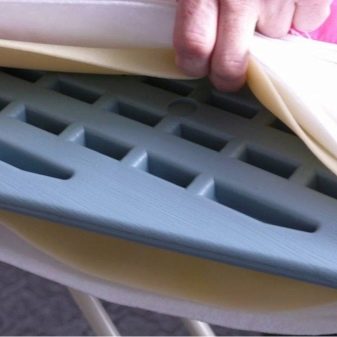
Metal
Metal ironing boards are also very popular today. The lion's share of modern manufacturers make such structures from lightweight aluminum. Such specimens are durable and have an attractive appearance. However, it must be borne in mind that metal boards inevitably become covered with red spots over time.
If you find a more durable model made of waterproof aluminum in the store, then you will need to treat it very carefully and carefully. Such products bend too easily, they can be damaged by accident.
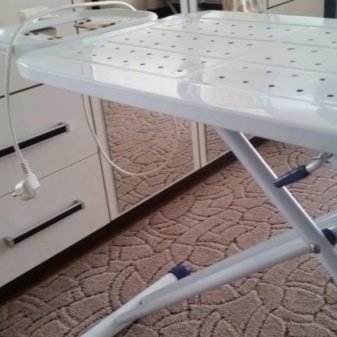
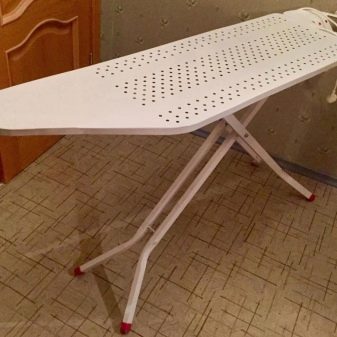
Ironing board upholstery also varies. Typically used are such types of textiles as:
- canvas;
- cotton fabrics;
- heat-resistant synthetics;
- carbon fiber.
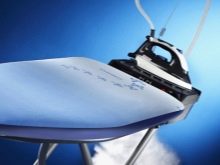
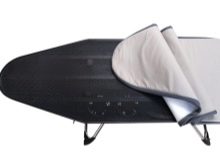

The following are used as stuffing materials:
- foam rubber;
- synthetic winterizer;
- batting.
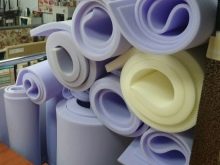
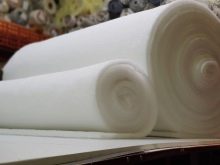
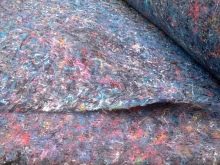
Sizes of different models
As mentioned above, ironing boards are available in different sizes. Consider the standard dimensions of various options for these devices.
Small-sized specimens have the following parameters:
- working area width - 30-35 cm;
- length - about 110-120 cm;
- the height of the board in the assembled state - standard - 133-143 cm;
- folded model thickness - 7 cm.
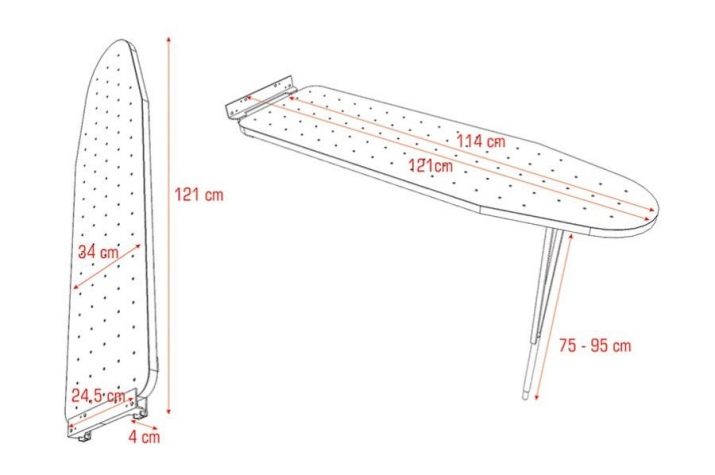
If there is a fairly spacious area in the room where the board is located, then you can pick up a larger model with a working area of 38-40 cm and a length of 140-145 cm.
When folded, larger models can be 163-168 cm long and 7 cm wide.
Most often, there are structures on sale with the following overall values:
- 110x30, 120x38, 130x45 (dimensions that are considered optimal) - such dimensions generally have the usual classic options with a length of at least 100 cm;
- 130x35, 150x45-46 - new, larger models are made with these parameters;
- 130x35 - these dimensions have side tables or dressers in a disassembled state;
- 128x38 - with these dimensional parameters, built-in boards go on sale (of course, consumers have the opportunity to purchase a product to order according to individual sizes);
- 70x30 - these are the dimensions of a modest mini-board of a desktop format.

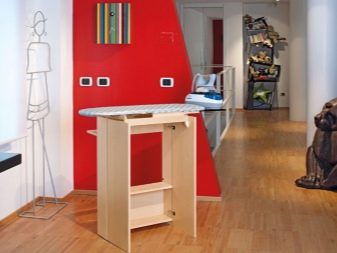
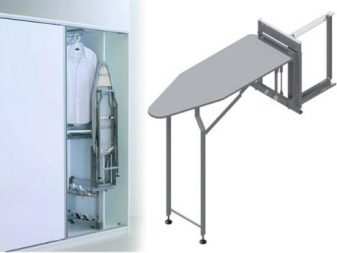
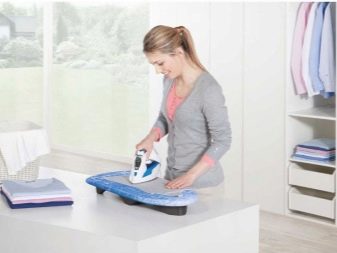
When choosing the right ironing board, it is very important to pay attention to its size. Please note that this structure should not block the passage in the room or be too close to other pieces of furniture. Otherwise, it will be completely inconvenient to use the tabletop, especially if it is a large desktop or built-in one.
Tips for choosing an ironing board in the video below.








